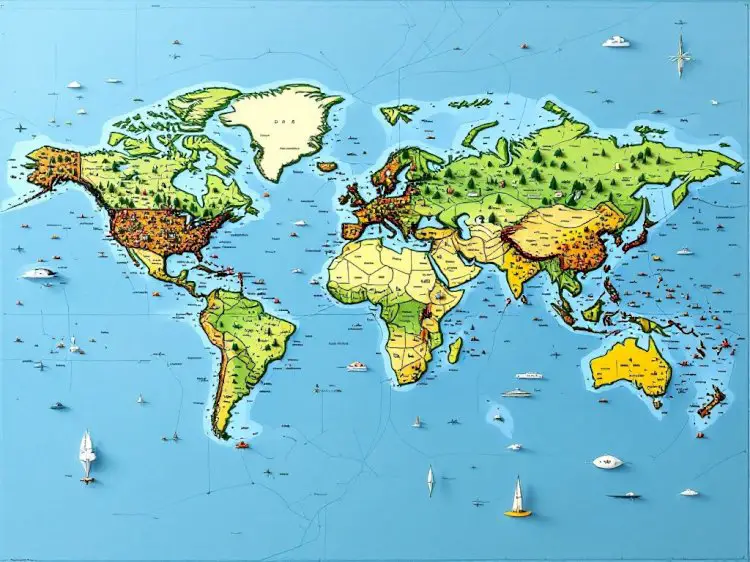How People Drew Maps Throughout History
Maps have been an integral part of human civilization for thousands of years, serving as tools for navigation, communication, and understanding the world around us. The history of mapmaking, also known as cartography, is a testament to human ingenuity and our persistent desire to explore and document our surroundings. This article delves into the fascinating evolution of mapmaking techniques, exploring the methods, tools, and challenges faced by cartographers throughout history.

Early Cartography and the Challenges Faced
Early maps were often rudimentary, reflecting the limited knowledge and technology available at the time. Ancient civilizations, such as the Babylonians and Greeks, created maps on clay tablets, cave walls, and papyrus. These maps primarily served to depict local areas and important landmarks [1].
One of the earliest known world maps was created by the Babylonians around 600 BCE [2]. This map, while symbolic rather than geographically accurate, provides valuable insights into the Babylonian worldview. The ancient Greeks made significant contributions to cartography, with Anaximander considered one of the first cartographers to draw a map of the known world [1]. Greek cartographers like Hecataeus, Herodotus, Eratosthenes, and Ptolemy further advanced the field by incorporating explorer observations and mathematical calculations into their maps [1]. Ptolemy's contribution was particularly significant, as he introduced a coordinate system with parallels of latitude and meridians of longitude, which formed the basis for modern maps. His atlas, "Geographia," is considered a landmark in cartographic history [1].
Early cartographers faced numerous challenges in their quest to accurately represent the world:
- Completeness: Ensuring that maps encompassed all known lands and oceans was a significant hurdle. Unknown areas were often filled with mythical creatures or left blank (terra incognita) [3].
- Scale: As maps expanded to cover larger areas, maintaining accuracy and detail became increasingly difficult [3].
- Information Flow: The circulation of geographic information was limited, hindering the creation of accurate and comprehensive maps [4].
- Limited Instruments and Information: Early cartographers relied on basic tools and often lacked reliable information about distant lands [5].
- Determining Longitude: Accurately determining east-west position (longitude) posed a major challenge for navigators and mapmakers. This was due to the lack of accurate timekeeping devices at sea [6].
- Mapping Socio-Economic Spaces: As cartography evolved, new challenges emerged in mapping socio-economic spaces, which required different approaches and forms of data portrayal [7]. This highlights the dynamic nature of cartography and its expanding scope beyond physical geography.
Tools and Techniques of Mapmaking
The tools and techniques used in mapmaking have evolved significantly throughout history. Here's a glimpse into this evolution:
Ancient Tools
Some of the earliest tools used in mapmaking include:
- Compasses: Invented in China, compasses allowed cartographers to determine direction by aligning a magnetized needle with the Earth's magnetic field [8].
- Protractors: These simple semi-circular disks, graduated in degrees, were used to measure angles, which was essential for creating accurate maps [9].
Surveying Techniques
As mapmaking progressed, more sophisticated techniques were developed for surveying and measuring the Earth's surface:
- Chains and Ropes: Surveyors used chains and ropes of known lengths to measure distances between points [10].
- Magnifying Glasses and Telescopes: These tools were used in conjunction with compasses to measure angles between distant points [10].
- Triangulation: This method involved measuring the angles between at least three reference points with known locations to determine the position of other points [10].
Navigation Techniques
For explorers and navigators, accurate maps were crucial for charting their journeys:
- Sextants: Developed in the 18th century, sextants allowed for precise measurement of angles between two objects, further enhancing the accuracy of maps, particularly for seafaring purposes [12].
- Dead Reckoning: This technique involved determining direction and distance along a route using a compass and various methods for measuring distance, such as counting steps, using a log-line in rivers, or employing tools like viameters (odometers) and Gunter's chain for more precise measurements [13].
Topographic Mapping
The development of tools for measuring elevation led to more accurate representations of terrain:
- Theodolites: These instruments were used to measure both horizontal and vertical angles, crucial for surveying and creating topographic maps [8].
- Barometers: Barometers were used to measure the height of mountains and hills, contributing to the accuracy of topographic maps [13].
- Geodetic Control Networks: These networks of precisely measured control points served as reference markers for mapping, ensuring consistency and accuracy across large areas [8].
Evolution of Mapmaking Techniques
Mapmaking techniques have undergone a remarkable evolution, driven by technological advancements and a growing understanding of the Earth.
- The Printing Press: The invention of the printing press in the 15th century revolutionized mapmaking by enabling mass production and distribution of maps [14]. This led to wider access to maps and a greater standardization of geographical knowledge.
- The Age of Exploration: The Age of Exploration (15th-17th centuries) had a profound impact on mapmaking. As explorers ventured into new territories, the demand for accurate maps increased, leading to the development of more precise techniques and new projection methods [9].
- The Mercator Projection: Developed by Gerardus Mercator in 1569, this projection allowed for the representation of a spherical Earth on a flat surface while preserving shapes and directions, making it invaluable for navigation [14].
- Lithographic and Photo-chemical Technology: These advancements in the 19th century allowed for the creation of more detailed and accurate maps [15]. The 19th century also witnessed a significant shift in mapmaking, with the rise of new printing technologies, the introduction of color printing, and the formalization of cartography as a profession [18]. Industrialized aesthetics began to influence map design, leading to more visually appealing and informative maps [18].
- From Individual Pursuit to Formalized Discipline: Mapmaking transitioned from an individual pursuit to a more formalized discipline in the 19th century, coinciding with the rise of geography as an academic subject [19]. This led to greater collaboration and standardization in mapmaking practices.
- Aerial Photography: The development of aerial photography in the 20th century provided a new perspective for mapmaking, allowing for the capture of large-scale images of the Earth's surface [15].
- Satellite Imagery and Remote Sensing: These technologies further revolutionized mapmaking by providing high-resolution images and data from space [15].
- Computer Technology and GIS: The advent of computers and Geographic Information Systems (GIS) has transformed cartography, enabling the creation of dynamic, interactive maps with vast amounts of data [15].
- Limitations of Paper Maps: Before the digital age, maps were primarily created on paper. While paper maps were portable, they had limitations. Errors could arise from accidental movements or miscalculations during the drafting process [9]. Updating paper maps was also cumbersome, requiring the creation of entirely new maps.
Types of Maps and Their Purposes
Maps are created for a variety of purposes [20]. Different types of maps have evolved to serve these needs, each with its own unique characteristics and applications:
|
Map Type |
Purpose |
Key Features |
|---|---|---|
|
General Purpose Maps |
To depict natural and man-made features of general interest. |
Shows landforms, bodies of water, roads, and cities [21]. |
|
Thematic Maps |
To highlight specific themes or data. |
Displays information like population density, climate patterns, or economic activity [21]. |
|
Political Maps |
To show political boundaries. |
Depicts countries, states, and cities [20]. |
|
Physical Maps |
To depict the physical features of an area. |
Shows mountains, rivers, and deserts [20]. |
|
Topographic Maps |
To represent elevation and terrain. |
Uses contour lines to show changes in elevation [22]. |
|
Economic or Resource Maps |
To show the distribution of economic activities or natural resources. |
Uses symbols or colors to represent different resources or economic activities [23]. |
|
Road Maps |
To show roads, highways, and transportation routes. |
Highlights major and minor roads, often with different colors and line thicknesses [23]. |
|
Climatic Maps |
To depict climate information. |
Shows temperature and rainfall patterns, often using colors to represent different climate zones [24]. |
The Role of Maps in Human History and Culture
Maps have played a crucial role in human history and culture, shaping our understanding of the world and influencing exploration, trade, and warfare. They have served as:
- Tools of Navigation: Maps have guided explorers, travelers, and traders across land and sea for centuries [25]. The accuracy of maps has been vital for safe and efficient travel, enabling the exploration of new lands and the establishment of trade routes.
- Records of Exploration: Maps have documented the discoveries of new lands and territories, expanding our knowledge of the world [26]. They serve as historical records of exploration, showing the routes taken by explorers and the features they encountered.
- Instruments of Power and Control: Maps have been used to assert territorial claims, plan military campaigns, and administer empires [27]. They have been essential tools for governments and rulers in managing their territories and projecting their power.
- Reflections of Culture and Worldview: Maps often reflect the cultural values and perspectives of the societies that create them [28]. The way maps are designed and the information they prioritize can reveal cultural biases and worldviews.
- Sources of Historical Information: Historical maps provide valuable insights into past landscapes, settlements, and cultural practices [27]. They can be used to study historical geography, urban development, and the evolution of human settlements.
Conclusion
The history of mapmaking is a testament to human curiosity, ingenuity, and our enduring fascination with the world around us. From rudimentary sketches on cave walls to sophisticated digital maps, cartography has evolved dramatically over time. Technological advancements, coupled with a growing understanding of geography and the Earth's shape, have led to increasingly accurate and detailed maps. This evolution has not only helped us understand the physical world but also shaped our understanding of ourselves, our societies, and our place in history. Maps have been instrumental in exploration, trade, warfare, and the administration of territories. They have also served as cultural artifacts, reflecting the worldviews and values of different societies. Today, maps continue to play a vital role in our lives, serving as essential tools for navigation, communication, and understanding our place in the world.
References
- The History of Cartography - ThoughtCo, accessed January 15, 2025, https://www.thoughtco.com/the-history-of-cartography-1435696
- Mapping the World: A Short History of Cartography, accessed January 15, 2025, https://historyguild.org/mapping-the-world-a-short-history-of-cartography/
- World map | Definition, History, Challenges, & Facts | Britannica, accessed January 15, 2025, https://www.britannica.com/science/world-map
- Conceptual Problems in the History of Cartography: A Manifesto for the Study of Early Mapmaking - Rare Book School, accessed January 15, 2025, https://rarebookschool.org/wp-content/uploads/2016/02/Conceptual-Problems-in-the-History-of-Early-Cartography.pdf
- Historical Cartography: Maps & Impact | Vaia, accessed January 15, 2025, https://www.vaia.com/en-us/explanations/archaeology/archaeology-documentation/historical-cartography/
- Navigational challenges and solutions | Archaeology of the Age of Exploration Class Notes, accessed January 15, 2025, https://library.fiveable.me/archaeology-of-the-age-of-exploration/unit-5/navigational-challenges-solutions/study-guide/XY7ke4y8AmlY5qMI
- CHALLENGES AHEAD FOR THE MAPPING PROFESSION J.C. Muller International Institute for Aerospace Survey and Earth Sciences 350 Boul - Cartography and Geographic Information Society, accessed January 15, 2025, https://cartogis.org/docs/proceedings/archive/auto-carto-9/pdf/challenges-ahead-for-the-mapping-profession.pdf
- How are maps created? | HERE, accessed January 15, 2025, https://www.here.com/learn/blog/how-are-maps-created
- The Evolution of Cartography Tools: From Ancient Maps to Modern Technology, accessed January 15, 2025, https://www.proxi.co/blog/cartography-tools
- How Were Maps Made Before Planes and Satellites - Ancient Survey Equipment And Techniques | Engineering Supply - EngineerSupply, accessed January 15, 2025, https://www.engineersupply.com/How-were-maps-made-before-planes-and-satellites.aspx
- www.here.com, accessed January 15, 2025, https://www.here.com/learn/blog/how-are-maps-created#:~:text=Apart%20from%20the%20compass%2C%20another,reference%20points%20with%20known%20locations.
- The Cartography Tools Of Our Past - Land id, accessed January 15, 2025, https://id.land/blog/the-cartography-tools-of-our-past
- Lewis and Clark : Cartography - EdGate, accessed January 15, 2025, http://www.edgate.com/lewisandclark/cartography.html
- History of Cartography - Atlas.co, accessed January 15, 2025, https://atlas.co/blog/history-of-cartography/
- The Evolution of Cartographic Mapping - J. Willard Marriott Library Blog, accessed January 15, 2025, https://blog.lib.utah.edu/evolution-cartographic-mapping/
- Mapping Through the Ages: The History of Cartography - Geography Realm, accessed January 15, 2025, https://www.geographyrealm.com/mapping-through-the-ages/
- The evolution of maps: From paper to Soar, accessed January 15, 2025, https://about.soar.earth/blog-pages/the-evolution-of-maps-from-paper-to-soar-earth
- Volume 5, Cartography in the Nineteenth Century, Forthcoming - UW–Madison Geography, accessed January 15, 2025, https://geography.wisc.edu/histcart/volume-5-cartography-in-the-nineteenth-century/
- The Early Evolution of Cartography | ArcNews | Fall 2021 - Esri, accessed January 15, 2025, https://www.esri.com/about/newsroom/arcnews/the-early-evolution-of-cartography/
- 6th Grade Social Studies - Types of Maps - Google Sites, accessed January 15, 2025, https://sites.google.com/view/watterson/unit-1-geography/types-of-maps
- Types of Maps | GEOG 486: Cartography and Visualization, accessed January 15, 2025, https://www.e-education.psu.edu/geog486/node/641
- Types of Maps: Exploring Geographic & Thematic Varieties - Woosmap, accessed January 15, 2025, https://www.woosmap.com/blog/types-of-maps
- Types of Maps - Exploros, accessed January 15, 2025, https://www.exploros.com/summary/Types-of-Maps-2
- 8 Different Types of Maps? - Geography for Kids - Mocomi, accessed January 15, 2025, https://mocomi.com/types-of-maps/
- The Maps' Importance in Human History Essay (Critical Writing) | Free Paper Example for Students - Aithor, accessed January 15, 2025, https://aithor.com/essay-examples/the-maps-importance-in-human-history-essay-critical-writing
- artsandculture.google.com, accessed January 15, 2025, https://artsandculture.google.com/story/examine-important-maps-in-history-unesco-memory-of-the-world/BwUBQg5_6TwbfA?hl=en#:~:text=Maps%20are%20one%20of%20the,track%20the%20evolution%20of%20cartography.
- Thinking about World History: Historic Maps as Sources, accessed January 15, 2025, https://dcc.newberry.org/?p=14376
- Examine Important Maps in History — Google Arts & Culture, accessed January 15, 2025, https://artsandculture.google.com/story/examine-important-maps-in-history-unesco-memory-of-the-world/BwUBQg5_6TwbfA?hl=en
- The Use of Maps in Cultural and Historical Studies - GeoMart, accessed January 15, 2025, https://geomart.com/blogs/geomart-blog-just-what-we-find-interesting/the-use-of-maps-in-cultural-and-historical-studies
- Maps, Methods, and Motifs – AHA - American Historical Association, accessed January 15, 2025, https://www.historians.org/perspectives-article/maps-methods-and-motifs/
What's Your Reaction?

















